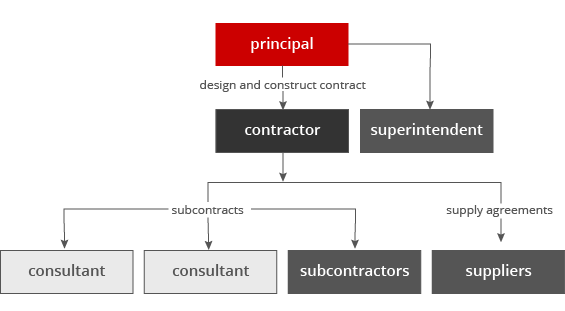Chapter 2 Design and construct
Overview
The principal engages:
- first, a consultant to prepare a preliminary design; and
- second, a contractor to complete and take responsibility for the design and to construct the project.
This delivery method generally reduces the principal’s risk and increases the contractor’s risk.
The design and construct model is often used for large scale domestic buildings (eg apartments), large commercial buildings and infrastructure work (eg road and rail projects).
Contractual relationships
The principal usually engages design consultants in the first instance. Design consultants typically carry out the design to completion of the preliminary design stage and help to prepare the principal’s project requirements, which is a functional brief for the project.
The principal then engages a contractor, who undertakes to meet the principal’s project requirements by:
- completing the design (they may take over consultants used by the principal or engage other consultants to develop the design further and document the design); and
- constructing the building.
This creates a single point of accountability for design and construction with the contractor.
Generally the principal engages a superintendent to administer the contract.
The design and construct method can be varied such that the contractor also takes on responsibility for maintenance of the asset once constructed: this is called a design, construct and maintain (DCM) delivery method.
The DCM method places additional responsibilities on the contractor during the design and construction phases, because the contractor will be more mindful when considering the operability and maintenance of the asset post-construction.
That variation on the contractor’s liability can be beneficial for the principal, and has been popular for large road projects and several water desalination plant projects. The delivery model for many public-private partnerships is effectively DCM with an added ownership and finance element.

Advantages
- The principal reduces its risk because the contractor is a single point of responsibility for design and construction.
- The principal can utilise a contractor’s full expertise, eg design responsibility drives design / construction efficiencies.
- There is less scope for variations related to design.
- Collaboration during the design and construction phases are enhanced.
- The construction phase is fast-tracked (sign-off on the ‘design and construct’ is earlier than on ‘construct only’).
- Well established standard form contracts are available.
Disadvantages
- The principal has less control over the final design.
- The contract sum may be higher to reflect increased contractor risks.
- Design development may be difficult to distinguish from a variation which may be the source of disputes.
Standard form contracts
AS 4300-1995: General Conditions for design and construct
AS 4902-2000: General conditions for design and construct
AS 4903-2000: Subcontract conditions for design and construct
PC-1 (1998): Property Council Contract
